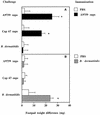Identification and cloning of a cryptococcal deacetylase that produces protective immune responses
- PMID: 11953374
- PMCID: PMC127888
- DOI: 10.1128/IAI.70.5.2383-2391.2002
Identification and cloning of a cryptococcal deacetylase that produces protective immune responses
Abstract
Cell-mediated immunity plays a crucial role in host defenses against Cryptococcus (Filobasidiella) neoformans. Therefore, the identification of cryptococcal antigens capable of producing T-cell-mediated responses, such as delayed-type hypersensitivity (DTH) reactions, may be useful in the development of immune-based strategies to control cryptococcosis. In order to characterize DTH-producing antigens, culture supernatants from the unencapsulated Cap-67 strain were separated by anion-exchange chromatography. After further fractionation by preparative sodium dodecyl sulfate-polyacrylamide gel electrophoresis, a purified protein with an apparent molecular mass of 25 kDa was found to produce DTH, as evidenced by increased footpad swelling in mice immunized with culture supernatants, relative to unimmunized mice. The 20-amino-acid N-terminal sequence of the 25-kDa protein was used to search data of the C. neoformans Genome Project. Based on the genomic DNA sequence, a DNA probe was used to screen a lambda cDNA library prepared from strain B3501. Clones were isolated containing the full-length gene (d25), which showed homology with a number of polysaccharide deacetylases from fungi and bacteria. The recombinant d25 protein expressed in Escherichia coli was similar to the natural one in DTH-producing activity. Moreover, immunization with either the natural or the recombinant protein prolonged survival and decreased fungal burden in mice challenged with the highly virulent C. neoformans strain H99. In conclusion, we have described the first cryptococcal gene whose product, a 25-kDa extracellular polysaccharide deacetylase, has been shown to induce protective immunity responses.
Figures










References
-
- Abrahams, J., and T. G. Gilleran. 1960. Studies on actively acquired resistance to experimental cryptococcosis in mice. J. Immunol. 85:629-635.
-
- Chaka, W., A. F. M. Verheul, V. V. Vaishnav, R. Cherniak, J. Scharringa, J. Verhoef, H. Snippe, and I. M. Hoepelman. 1997. Cryptococcus neoformans and cryptococcal glucuronoxylomannan, galactoxylomannan, and mannoprotein induce different levels of tumor necrosis factor in human peripheral blood mononuclear cells. Infect. Immun. 65:272-278. - PMC - PubMed
-
- Chaka, W., A. F. M. Verheul, V. V. Vaishnav, R. Cherniak, J. Scharringa, J. Verhoef, H. Snippe, and A. I. M. Hoepelman. 1997. Induction of TNF-α in human peripheral blood mononuclear cells by the mannoprotein of Cryptococcus neoformans involves human mannose binding protein. J. Immunol. 159:2979-2985. - PubMed
Publication types
MeSH terms
Substances
Grants and funding
LinkOut - more resources
Full Text Sources
Other Literature Sources
Miscellaneous

